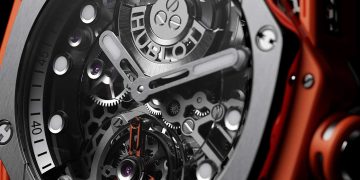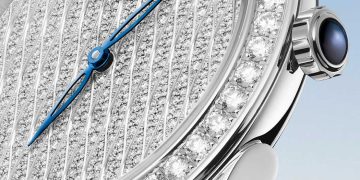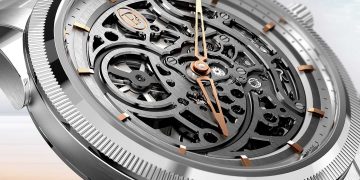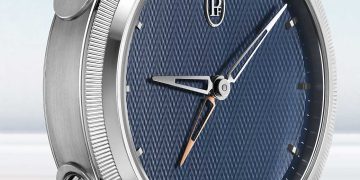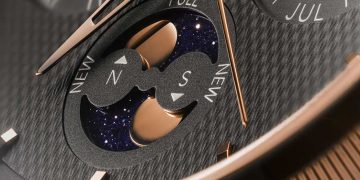At first glance, the Orb looks like a futuristic model of an eye with its perfectly formed shiny sphere, and its dial taking the place of the iris and the pupil. But nothing is ever quite what it seems with the collaborative clocks of MB&F x L’Epée 1839.
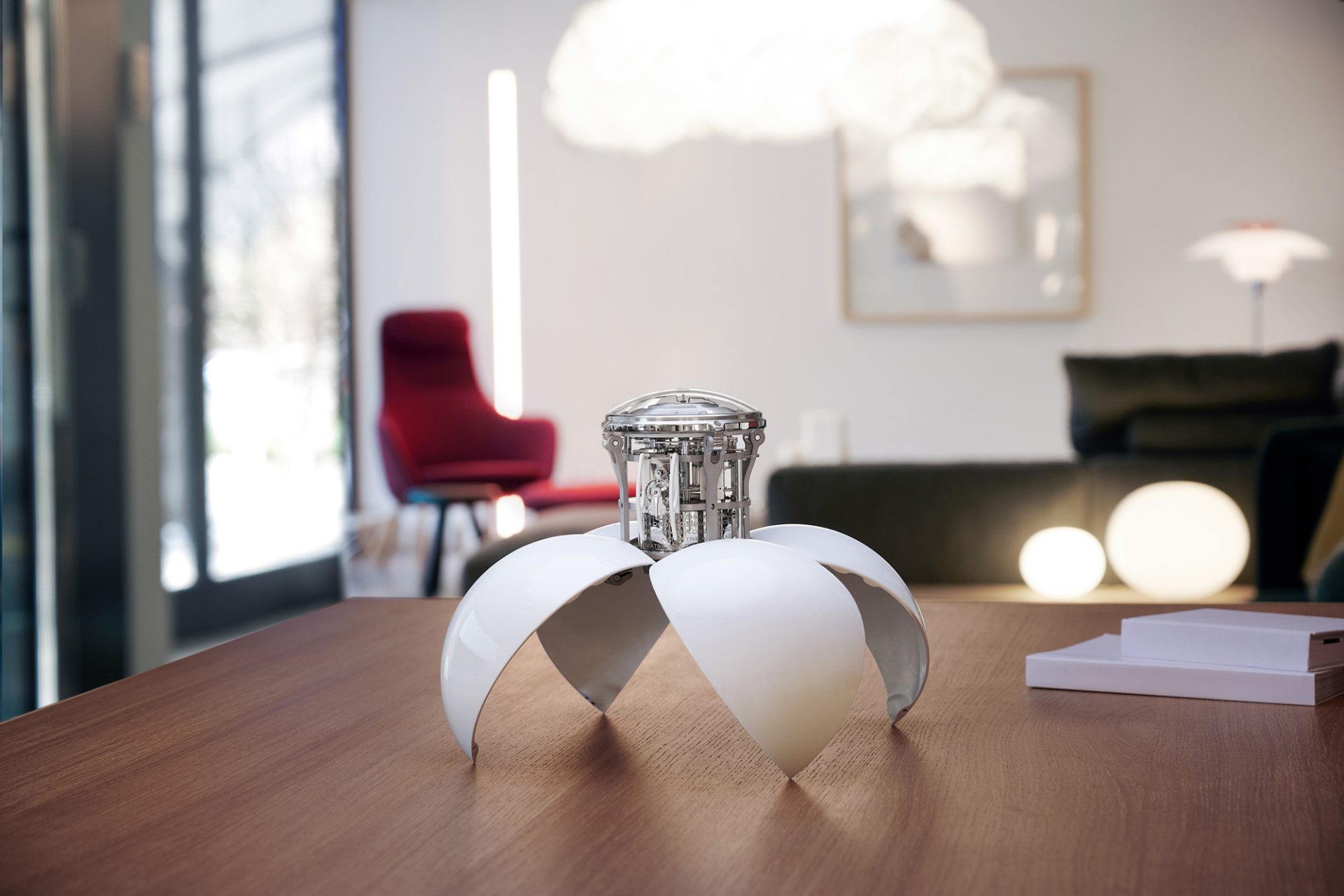
The minimalistic structure is composed of four elytra (that’s the technical word for a beetle’s protective wing covers, in case you were wondering) that not only open up, but can also swivel like a transformer to display the Orb in a variety of different positions. The shiny-white version is reminiscent of the first iPods with their lustrous curved cases, a surface that is particularly pleasing to the eye and the touch.
The possibilities of displaying the ORB are multiple. Placed on its saucer so it doesn’t roll away, it can be displayed completely closed or with one, two or three opened elytra. Alternatively, opening all four elytra allows to display the clock without the saucer.
Orb starts life as a solid block of aluminium that is then hollowed to create the perfect sphere. Once cut, the elytra are then coated with several layers of lacquer that are hardened in a kiln to create the brilliant finish. The four elytra are soldered to the structure with torque hinges so they can retain their angle however little or wide they are opened. When closed, the elytra are held in place with four tiny magnets on the interior of each tip to keep the shape of a perfect sphere.
Powering this state-of-the-art clock is a beautiful L’Epée 1839 hour-striking movement with an eight-day power reserve. In contrast to many of the other MB&F x L’Epée clocks, the movement is not perceivable from the outside. But the perfectly formed sphere invites the viewer into the mechanical heart of the piece and the discovery of the movement.
The eight-day calibre can be seen just slightly through the curved aluminium dial covered by a domed mineral glass, which has a hole in the centre to allow the setting of the time with a special key.
There are two barrels, one for the time and the other for the striking of the hours, that are wound separately. The hour mechanism doesn’t just chime the passage of the hour, but indicates the actual hour, like a church clock. This function can also be repeated on demand via a button on the side of the clock, or turned on and off if required.
This new hour-striking development is based on a similar mechanism used in L’Epée 1839’s historic carriage clocks. In France, these are known as “Officer’s clocks” as legend has it that when Napoleon almost lost a battle because one of his officers was late, he ordered all of his military chiefs to carry a carriage clock with them at all times.
Available in white or black, the Orb won’t be able to accompany its owners out into the field, but with its hourly striking mechanism, it is a beautiful reminder of the time as it passes for all desk warriors!
ORB IN DETAIL
Inspiration
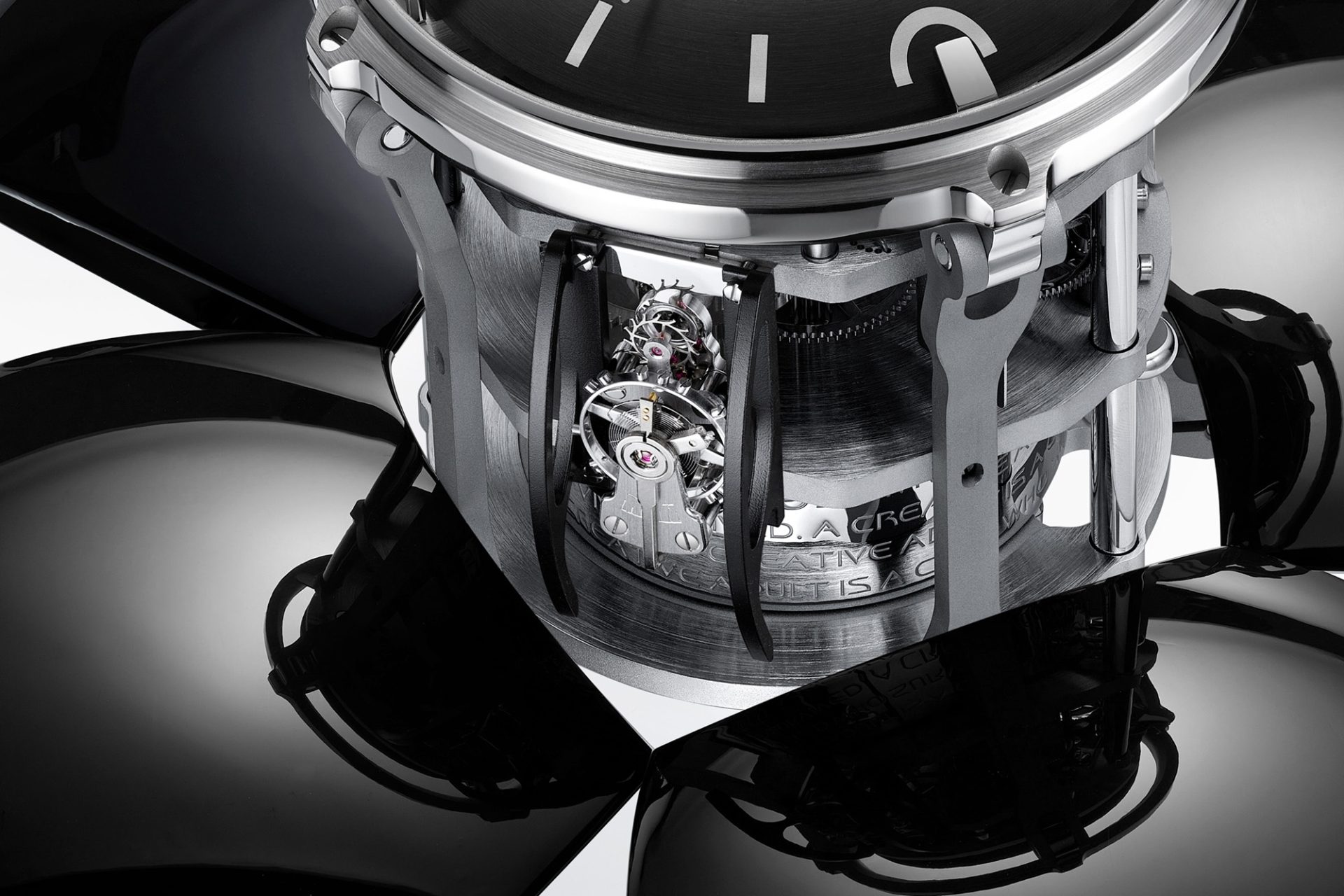
The idea behind the Orb is the brainchild of German designer Maximilian Maertens, who started his artistic career at MB&F as an intern before setting up his own design studio in Berlin. Maertens worked with MB&F and L’Epée on the T-Rex clock, before being given free rein to create the TriPod and now the Orb.
“Max (Maertens) is a natural born creator – something incredibly rare these days. His mind travels and explores his own universe before transforming that thought wandering process into a 3D idea. Our differences enrich the creative process whilst our similarities allow for both of us to understand each other”, says Maximilian Büsser, founder and creative director of MB&F.
Realisation
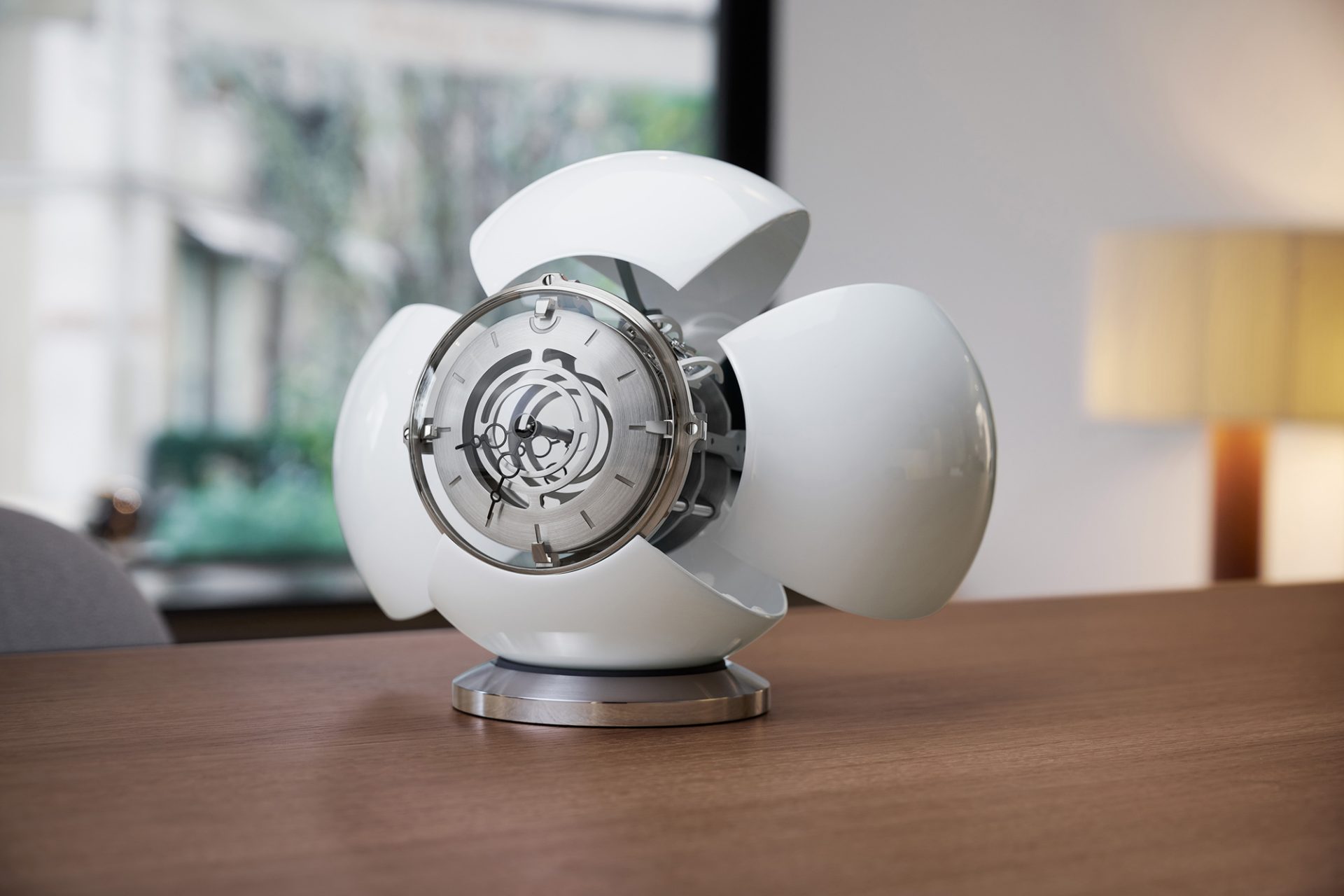
While Maximilian Maertens and MB&F came up with the concept and design of the Orb, it was L’Epée 1839, Switzerland’s premier clock maker, that developed the movement as well as the lacquered transformable sphere. L’Epée produces all the components, except for the mineral glass and the rubies, puts them all together and regulates the high precision, eight-day movement.
While nothing about this atypical project was easy, L’Epée faced two major challenges. The first was making the sphere in four pieces so that they could be totally transformable, durable, and also form a perfect sphere when closed.
The second significant challenge was developing the striking system. Usually, with a bell-chiming mechanism, gravity is needed to strike the bell. As the Orb’s brass bell can find itself in an infinite number of different positions, L’Epée 1839’s clockmakers incorporated several springs to strike the bell so it can chime even when it is flat. The system is a hybrid between a clock and a watch striking mechanism.
Orb
The word orb comes from the Latin orbis, meaning “circle” or “disk”. The word is also the basis of the word “orbit”, a word that has stayed in the modern-day vernacular even if orbits are now known to be elliptical and not at all round.
Orbs are also used today in fanfiction to mean eyes, as in “cerulean orbs” that designate blue eyes or “chocolate orbs” for brown eyes – a nod to perhaps the first thing that comes to mind when we first lay eyes on the Orb.
ORB: TECHNICAL SPECIFICATIONS
Orb is available in limited editions of 50 pieces each in white or black.
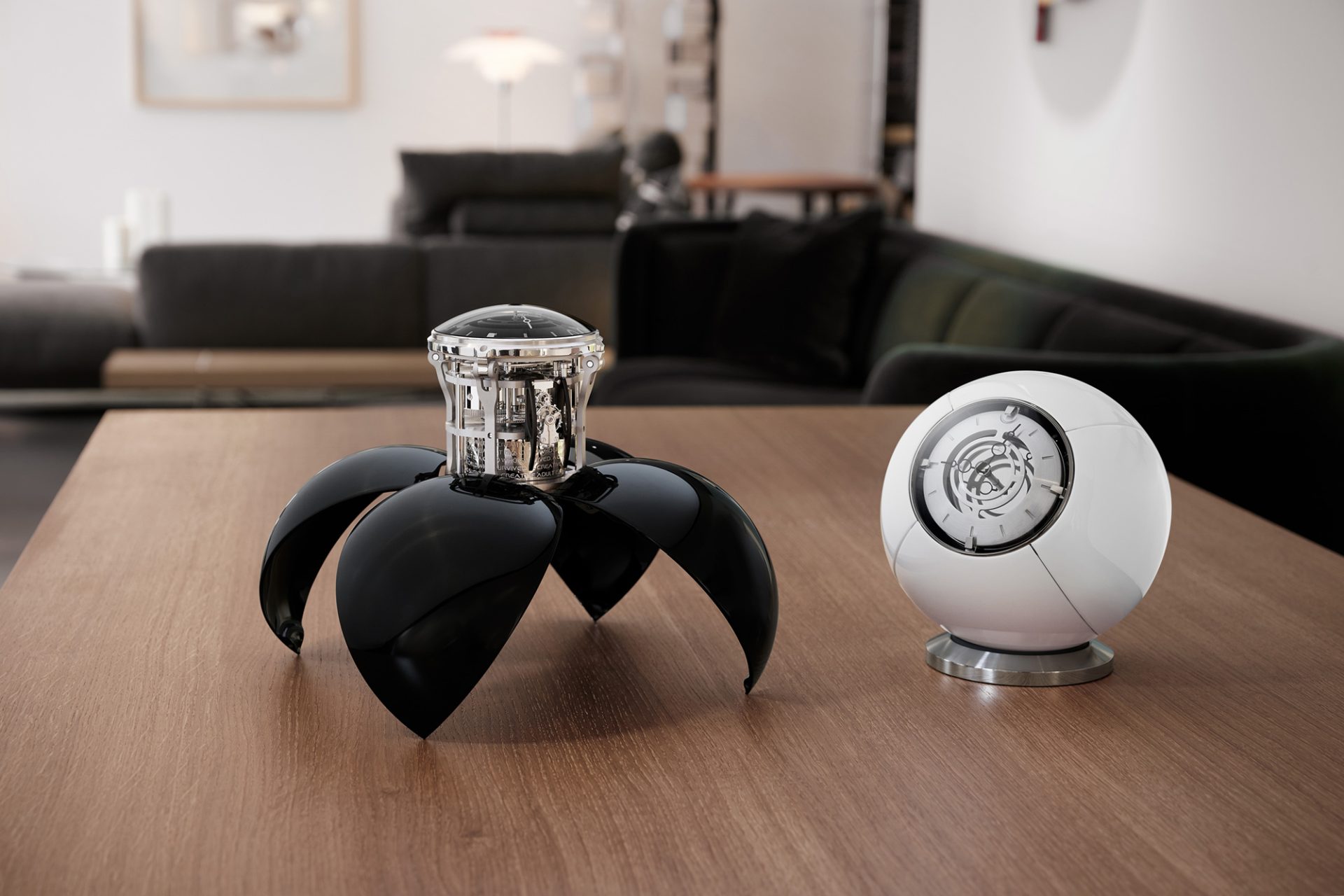
Display
Hours and minutes
Striking hour, repeated on demand via a button on the side of the clock, or turned on and off if required.
Body
Closed:
Height: approx. 17cm
Diameter: approx. 17cm
Opened (complete opening):
Height: approx. 24cm
Diameter: approx. 30cm
Number of elytra: 4
Number of parts: 165
Weight: 1.9kg
Materials: Clockwork in palladium-plated brass and stainless steel
Elytra in aluminium and covered with handmade lacquer
Movement
L’Epée 1839 in-house designed and manufactured movement
Balance frequency: 18,000bph / 2.5Hz
Two barrels, power reserve eight days
300 components
Jewels: 17
Incabloc shock protection system
Manual-winding: double-depth square socket key sets time and winds movement
Movement finishing: polishing, sandblasting, circular and vertical satin finishing and starburst decoration
L’EPEE 1839 – THE PREMIER CLOCK MANUFACTURE IN SWITZERLAND
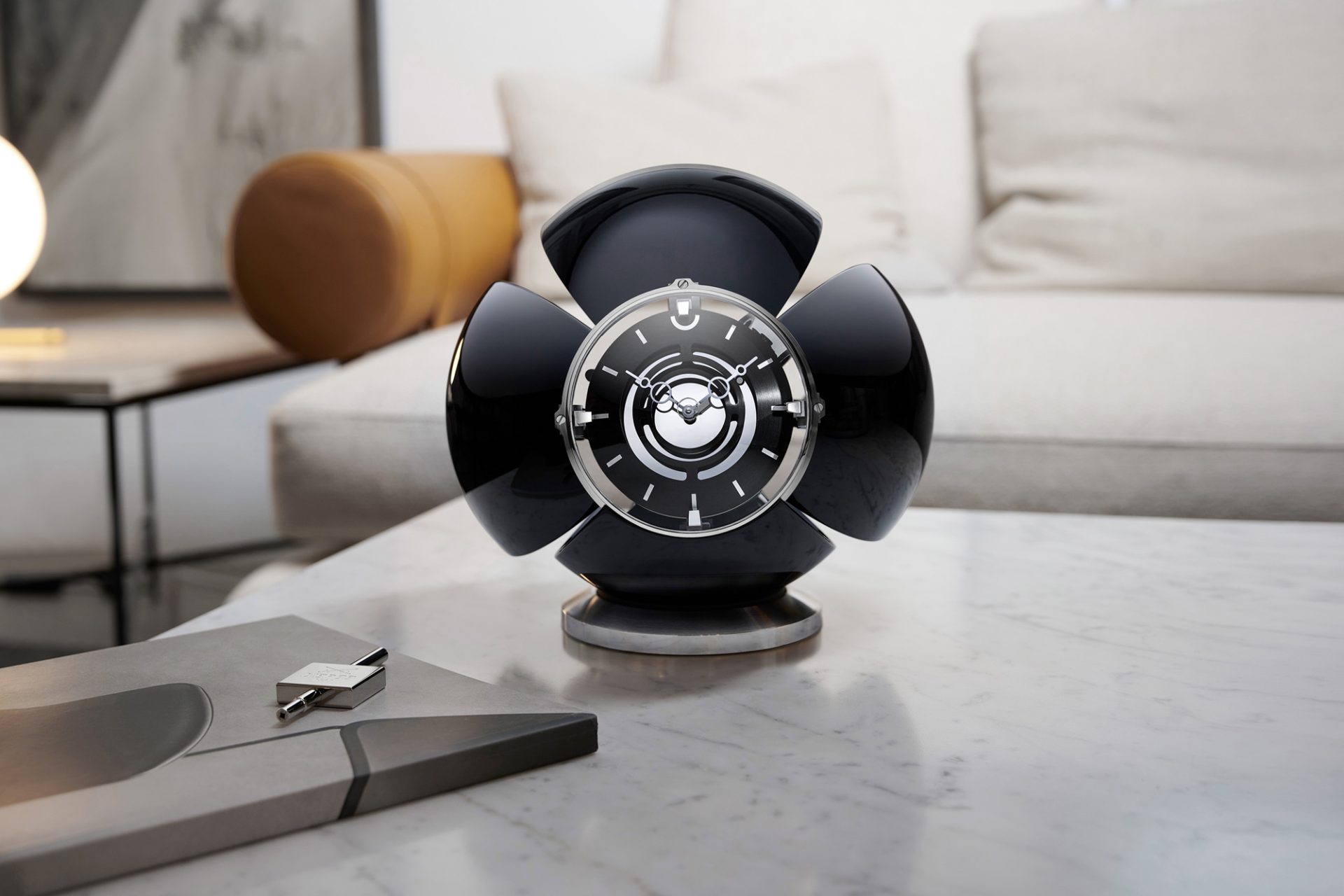
Dedicated to making high-end clocks, L’Epée has been a prominent Swiss Manufacture for over 180 years. Founded in 1839 by Auguste L’Epée in France’s Besançon region, the company originally focused on producing music boxes and watch components and became synonymous at the time with entirely handmade pieces.
From 1850, L’Epée became a leading light in the production of ‘platform’ escapements, creating regulators especially for alarm and table clocks and musical watches. It became a well-known specialist owning a large number of patents on exceptional escapements and the chief supplier of escapements to several celebrated watchmakers of the day. L’Epée has won a number of gold medals at international exhibitions.
During the 20th century, L’Epée owed much of its reputation to its superlative carriage clocks; for many, the clock of the influential and powerful in addition to being the gift of choice of French government officials to elite guests. In 1976 when the Concorde supersonic aircraft entered commercial service, L’Epée wall clocks were chosen to furnish the cabins, providing passengers with the time. In 1994, L’Epée showed its thirst for a challenge when it built the world’s biggest clock with a compensated pendulum, the Giant Regulator, which was recognised by the Guinness Book of Records.
L’Epée 1839 is now based in Delémont in the Swiss Jura Mountains, Switzerland. Under the impetus of its CEO Arnaud Nicolas, it has developed an exceptional table clock collection encompassing a full range of sophisticated timekeepers.
The collection is based around three themes:
Creative Art – first and foremost artistic models often developed in partnership with external designers as joint creations. These clocks surprise, inspire, and sometimes even shock the most seasoned collectors. They are intended for those consciously or unconsciously looking for exceptional, one-of-a-kind objects.
Contemporary Timepieces – technical creations with a contemporary design (Le Duel, Duet, etc.) and minimalist, avant-garde models (La Tour) incorporating complications such as retrograde seconds, power-reserve indicators, moon phases, tourbillons, chiming mechanisms, and perpetual calendars.
Carriage Clocks – carriage clocks, also known as “officer’s clocks”. These historical models stemming from the brand’s heritage also feature their fair share of complications including chiming mechanisms, minute repeaters, calendars, moon phases, tourbillons, and more.
All models are designed and manufactured in-house. Their technical prowess, combination of form and function, very long power reserves, and remarkable finishes have become signature features of the brand.
MB&F – GENESIS OF A CONCEPT LABORATORY
Founded in 2005, MB&F is the world’s first-ever horological concept laboratory. With almost 20 remarkable calibres forming the base of the critically acclaimed Horological and Legacy Machines, MB&F is continuing to follow Founder and Creative Director Maximilian Büsser’s vision of creating 3-D kinetic art by deconstructing traditional watchmaking.
After 15 years managing prestigious watch brands, Maximilian Büsser resigned from his Managing Director position at Harry Winston in 2005 to create MB&F – Maximilian Büsser & Friends. MB&F is an artistic and micro-engineering laboratory dedicated to designing and crafting small series of radical concept watches by bringing together talented horological professionals that Büsser both respects and enjoys working with.
In 2007, MB&F unveiled its first Horological Machine, HM1. HM1’s sculptured, three-dimensional case and beautifully finished engine (movement) set the standard for the idiosyncratic Horological Machines that have followed – all Machines that tell the time, rather than Machines to tell the time. The Horological Machines have explored space (HM2, HM3, HM6), the sky (HM4, HM9), the road (HM5, HMX, HM8) and the animal kingdom (HM7, HM10).
In 2011, MB&F launched its round-cased Legacy Machine collection. These more classical pieces – classical for MB&F, that is – pay tribute to nineteenth-century watchmaking excellence by reinterpreting complications from the great horological innovators of yesteryear to create contemporary objets d’art. LM1 and LM2 were followed by LM101, the first MB&F Machine to feature a movement developed entirely in-house. LM Perpetual, LM Split Escapement and LM Thunderdome broadened the collection further. 2019 marked a turning point with the creation of the first MB&F Machine dedicated to women: LM FlyingT; and MB&F celebrated 10 years of Legacy Machines in 2021 with the LMX. MB&F generally alternates between launching contemporary, resolutely unconventional Horological Machines and historically inspired Legacy Machines.
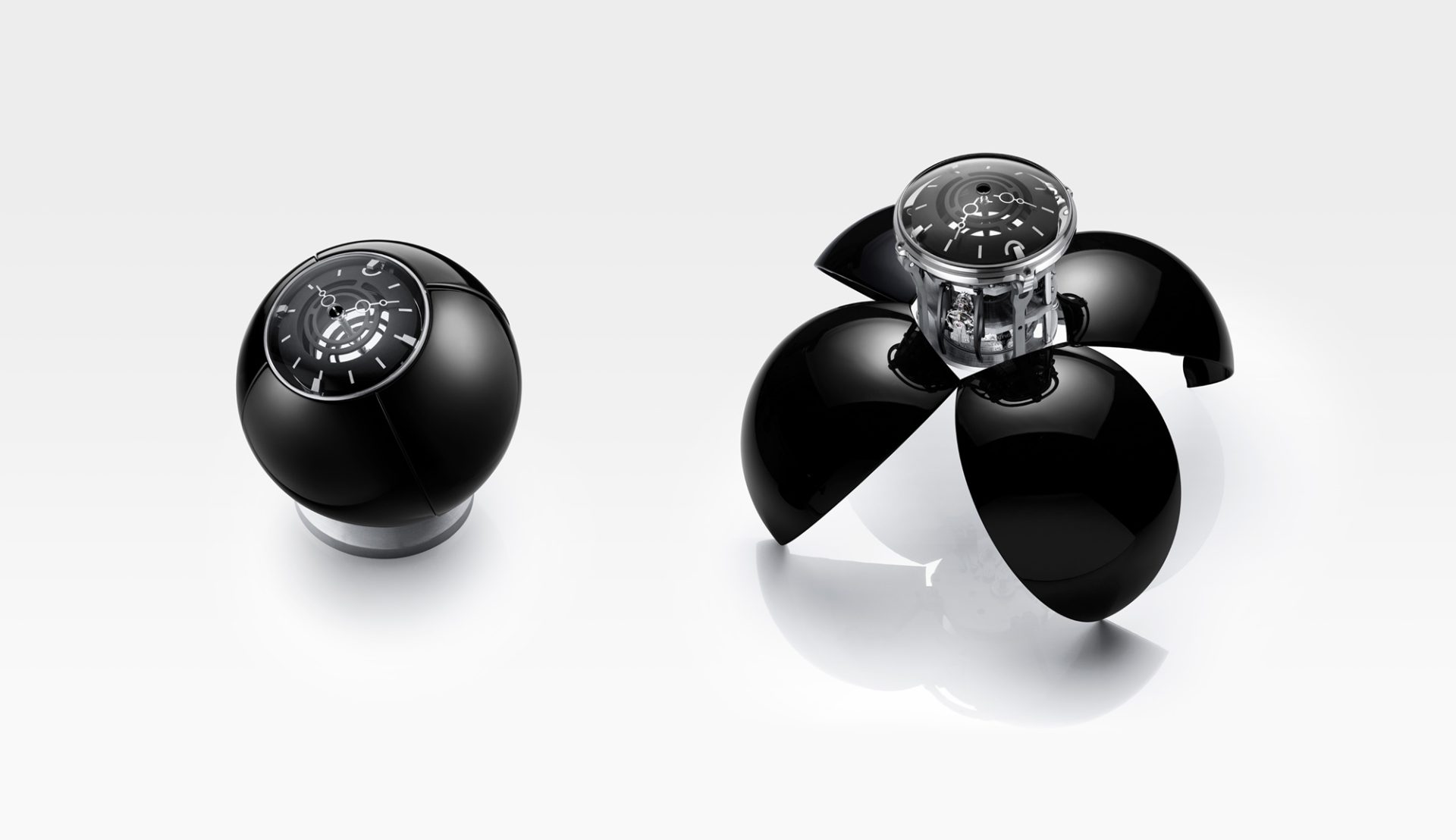
As the F stands for Friends, it was only natural for MB&F to develop collaborations with artists, watchmakers, designers and manufacturers they admire.
This brought about two new categories: Performance Art and Co-creations. While Performance Art pieces are MB&F machines revisited by external creative talent, Co-creations are not wristwatches but other types of machines, engineered and crafted by unique Swiss Manufactures from MB&F ideas and designs. Many of these Co-creations, such as the clocks created with L’Epée 1839, tell the time while collaborations with Reuge and Caran d’Ache generated other forms of mechanical art.
To give all these machines an appropriate platform, Büsser had the idea of placing them in an art gallery alongside various forms of mechanical art created by other artists, rather than in a traditional storefront. This brought about the creation of the first MB&F M.A.D.Gallery (M.A.D. stands for Mechanical Art Devices) in Geneva, which would later be followed by M.A.D.Galleries in Taipei, Dubai and Hong Kong.
There have been distinguished accolades reminding us of the innovative nature of MB&F’s journey so far. ‘To name a few, there have been no less than 7 awards from the famous Grand Prix d’Horlogerie de Genève: in 2021, MB&F received two prizes: one for LMX as the Best Men’s Complication and one for the LM SE Eddy Jaquet ‘Around The World in Eighty Days’ in the ‘Artistic Crafts’ category, in 2019, the prize for Best Ladies Complication went to the LM FlyingT, in 2016, LM Perpetual won the Best Calendar Watch award; in 2012, Legacy Machine No.1 was awarded both the Public Prize (voted for by horology fans) and the Best Men’s Watch Prize (voted for by the professional jury). In 2010, MB&F won Best Concept and Design Watch for the HM4 Thunderbolt. In 2015 MB&F received a Red Dot: Best of the Best award – the top prize at the international Red Dot Awards – for the HM6 Space Pirate.

